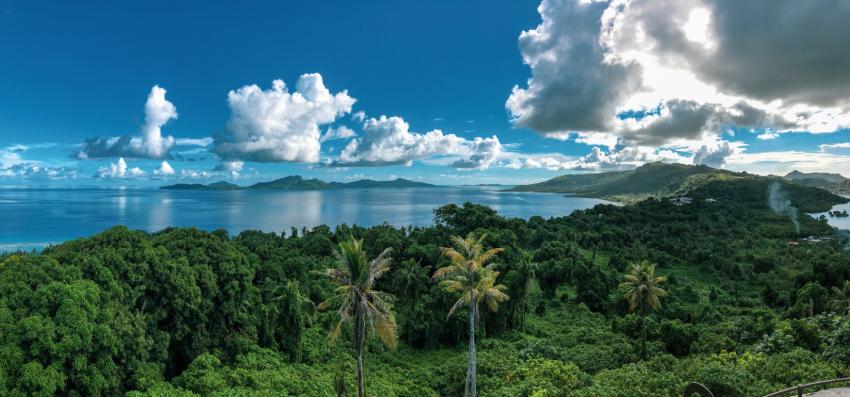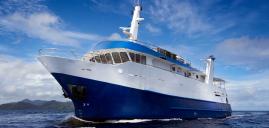LIVEABOARD DIVING IN Micronesia (Truk Lagoon)

2
liveaboards
Price from
USD 1,533 per trip
Diving in the Federated States of Micronesia, specifically at Truk Lagoon (also known as Chuuk Lagoon), presents a unique underwater experience steeped in history and natural beauty. Renowned for its wreck diving, Truk Lagoon is a major attraction for divers of all levels, offering an array of sunken treasures.Truk Lagoon holds a pivotal place in World War II history. In February 1944, Operation Hailstone, a massive U.S. naval air attack, targeted the Imperial Japanese Navy fleet anchored in the lagoon. This attack resulted in numerous shipwrecks, aircraft, and other military equipment sinking to the bottom of the lagoon, creating an underwater museum.
The wrecks in Truk Lagoon cater to a wide range of divers. Some wrecks are accessible at shallow depths, ideal for beginners or those with a recreational diving interest. In contrast, several wrecks lie beyond recreational diving depths, offering challenges to more experienced and technical divers. Besides the historical wrecks, divers in Truk Lagoon can encounter a diverse range of marine life. The wrecks have transformed into artificial reefs, teeming with colorful corals, anemones, and a variety of fish species. The clear waters and abundant sea life make for spectacular underwater photography opportunities.
The liveaboard's itinerary is thoughtfully crafted to showcase the best of Micronesia's underwater treasures, ensuring a fulfilling experience for both novice and experienced divers. The lagoon's sheltered waters generally offer calm and clear diving conditions, making it an ideal year-round diving destination. The water temperature is consistently warm, further enhancing the diving experience. A liveaboard trip in Micronesia is more than just diving; it's a journey that connects you with the ocean's rhythm and the untold stories of its depths. It's an experience that stays with you long after you've left its waters, calling you back to explore more of its hidden wonders
When To Go Diving in Micronesia (Truk Lagoon)
The Federated States of Micronesia has a tropical climate with distinct dry and wet seasons. The temperature doesn’t vary much by season, and averages 27-30°C/82-86°F throughout the year. The average water temperature is 28-29°C/82-84°F. The best time to visit the country is during the dry season, from January to June. There are heavy rains and occasional typhoons from July to December. Visibility is excellent almost everywhere and can exceed 30m/98ft. Currents are moderate, 1-2 knots. Micronesia’s spectacular underwater world with many species is a wonderful place for scuba divers to explore. Divers can easily encounter leaf fish, scorpionfish, lionfish, spotted eagle rays, manta rays, Napoleon wrasses, whitetip and blacktip reef sharks, octopi, and lots of tuna. Divers can examine coral gardens and alleys of underwater plants.
Frequently Asked Questions
The depths of dive sites in Micronesia, particularly in renowned areas like Truk Lagoon, vary widely, catering to a broad spectrum of divers from beginners to experienced technical divers. Here's an overview:
Shallow Reef Dives: Many sites in Micronesia offer shallow reef dives, typically ranging from 5 to 20 meters (15 to 65 feet). These sites are perfect for beginners, snorkelers, and those interested in a leisurely exploration of vibrant coral gardens teeming with marine life.
Intermediate Depths: A significant number of dive sites lie at intermediate depths, usually between 18 to 30 meters (60 to 100 feet). These sites are well-suited for advanced open water divers. They often feature fascinating topographies, such as coral walls, slopes, and sometimes the upper sections of larger wrecks.
Deep Wreck Dives: Truk Lagoon, in particular, is famous for its deep wreck dives, where many sunken ships and aircraft from World War II rest. These wrecks typically lie between 30 to 60 meters (100 to 200 feet) deep. These sites require advanced or technical diving skills due to their depth and the potential for penetration diving into the wrecks.
Technical Dive Sites: For technical divers, there are sites that go beyond 60 meters (200 feet). These dives are challenging and require specialized training, equipment, and planning. They offer a unique opportunity to explore less-visited parts of large wrecks or deeper reef systems.
Variable Depths for Exploration: Some of the larger wrecks in Micronesia, like those in Truk Lagoon, span a wide range of depths. For instance, a shipwreck might have its mast rising to within 15 meters (50 feet) of the surface while the hull rests at 30 meters (100 feet) or deeper. This variability allows divers of different skill levels to explore parts of the same site according to their certification and comfort level.
In summary, the dive sites in Micronesia offer a diverse range of depths, making it a versatile destination that caters to the preferences and skill levels of a wide variety of divers. Most liveaboard required minimum 50 logged dives, AOWD or equivalent. Whether it's shallow coral reefs or deep-sea wreck adventures, there's something for every diver in the waters of Micronesia
- Popular Dive Areas: The more popular diving destinations, like Truk Lagoon and Palau, are relatively accessible. These areas have well-established dive operations offering regular boat trips to various sites. For divers staying on land-based resorts or guesthouses, daily dive trips are organized, usually with short to moderate boat rides to reach the dive sites.
- Remote and Secluded Sites: Some dive sites, especially those located around the less frequented islands or atolls, are more remote and can be accessed only by longer boat trips or liveaboards. These sites are often less crowded and offer pristine diving conditions, but they require more time and commitment to reach.
- Liveaboard Accessibility: Liveaboards are a popular option in Micronesia for accessing a wider range of dive sites, including those that are more remote. They offer the advantage of staying directly on the water, reducing travel time to dive sites, and allowing divers to reach areas that might be too far for day trips from land-based operations.
- Weather and Sea Conditions: Accessibility is also subject to weather conditions and sea states. Certain times of the year might offer calmer seas and better visibility, making it easier to reach and enjoy dive sites. Conversely, rough weather can limit access to some sites, especially those that are more exposed or require longer boat journeys.
- Specialized Dive Sites: Some unique sites, like deeper wrecks or caves, may require special arrangements for access. These sites might need technical diving capabilities or specific permissions and are usually accessed with operators who specialize in this type of diving.
